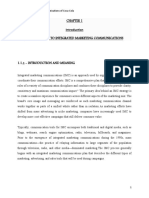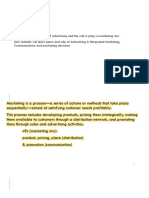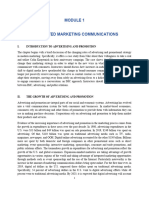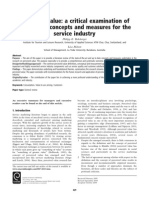IMC - The Importance of Message Consistency
IMC - The Importance of Message Consistency
Uploaded by
Hari Zainuddin RasyidCopyright:
Available Formats
IMC - The Importance of Message Consistency
IMC - The Importance of Message Consistency
Uploaded by
Hari Zainuddin RasyidOriginal Description:
Copyright
Available Formats
Share this document
Did you find this document useful?
Is this content inappropriate?
Copyright:
Available Formats
IMC - The Importance of Message Consistency
IMC - The Importance of Message Consistency
Uploaded by
Hari Zainuddin RasyidCopyright:
Available Formats
IMC, The Importance of Message Consistency Integrated marketing communication (IMC) involves the synergistic use of public relations
in tandem with other promotional tools to promote products, services, causes, or candidates. ORIGINS OF IMC The traditional tools in the "promotion mix" used by marketers include advertising, sales promotion, direct response, personal selling, and public relations/publicity. Clients have used these tools for many years, but beginning in the early 1990s marketers and advertisers began to recognize the importance of using these tools more effectively in combination. The advertising agency business, in particular, became alarmed about reduced spending on traditional space and time advertising. Clients were shifting dollars away from activities based on building long-term brand awareness and brand equity to activities that would generate more immediate, demonstrable results: trade and consumer promotions, direct response, and cause-related marketing and events. Agencies responded by promoting the idea that they could coordinate all these elements for clients and acquired or established alliances with companies with expertise in these other specialties. ELUSIVENESS OF INTEGRATION Early IMC theorizing called for an audiencecentered (versus activity-centered or product-centered) approach to marketing communications. Implicit in this approach was recognition that various tools could be used to reach audiences. Early IMC theorizing also emphasized the extension of the same metrics used to measure advertising to all communications efforts. Duncan (2002, p. 8) defined IMC as the "cross-functional process for creating and nourishing profitable relationships with customers and other stakeholders by strategically controlling or influencing all messages sent to these groups and encouraging data-driven purposeful dialogue with them." IMC advocates have identified a series of stages through which integration progresses: (a) awareness within the organization; (b) image integration, or the melding of messages and themes across communications activities; (c) functional integration of units responsible for producing messages; (d) consumer and database integration, where customer intelligence is brought together; (e) stake-holder integration to address groups beyond customers; and (f) technological integration, where communications with customers are both intelligent and interactive. These varying approaches suggest that integration is actually conceptualized and used in a variety of ways today. Full integration has been difficult to achieve due to structural, economic, creative, and tactical issues that continue to differentiate the disciplines involved in the process. Advertising continues to receive top priority in many programs because of the broad reach and awareness ads can create (and the large revenues generated from advertising for agencies). Sales promotion, direct response, and public relations are often ancillary activities, considered only after a creative direction for advertising is established. Full integration is also difficult because of the different creative, production, and distribution conventions used by these disciplines. Integrated communications campaigns invariably involve the conjoint efforts of communications professionals with different skills, training, and orientations who create different genres of communications that follow different conventions. Even with the best of intentions, these inherent differences pose misunderstandings and conflicts. Among some public relations practitioners, IMC has been viewed as anPgina 427 | Inicio del artculo encroachment by imperialistic marketers who seek to take over the public relations function. Public relations practitioners produce a wide range of tools that can be used in an IMC campaign. These
include product publicity, speeches and presentations, events (celebrations, tours, meetings, conferences), and school and club programs. Significantly, some tools commonly used in public relations also might be assigned to sales promotion or direct response specialists. Examples are publications (collateral), displays, exhibitions, audiovisuals, direct mail and email, and Web sites. Corporate advertising, cause-related marketing, and campaigns involving tie-ins with philanthropic organizations are examples of where traditional distinctions between public relations and marketing functions have become blurred. COORDINATION OF CAMPAIGN ELEMENTS An integrated marketing communications campaign, at minimum, requires three elements: (a) deployment of different tools and media to achieve the objectives or outcomes for which they are best suited, (b) timing of campaign elements to take maximum advantage of each, and (c) message consistency or continuity so that audiences recognize a topic or message as being familiar. Coordination Of Tools Integrated communication involves optimizing the effectiveness and efficiency of various marketing tools. Certain communications tools are especially well suited to achieve particular outcomes as outlined in Table 1. Coordination Of Message Timing Integration also involves purposefully disseminating messages using the same or different strategies to maximize results. In a new product introduction, for example, it is customary to lead with a new product publicity announcement to take full advantage of media interest and a product's inherent newsworthiness. Once fully exploited, publicity efforts are often reduced (unless there is ongoing news interest) and advertising begins. In-store sales promotion (point-of-purchase, etc.) often coincides with the initial advertising campaigns, but also can be used later to bolster interest when no public advertising is being used. Direct response often follows publicity and advertising, capitalizing on previous awareness and interest to stimulate ordering. Coordination Of Message Content Marketers seeking maximum integration and messages will ensure that messages carry common elements across communications tools wherever possible. Elements include common brand identification, spokespersons, and message themes (product promises, benefits, descriptions, and key facts). To the extent possible, consistent use of executional features of advertising such as logos, signatures, slogans, and graphic designs can provide important cues that attract attention, trigger recall, and facilitate learning and memory. The critical issue in message integration is consistencyspeaking with a "single voice." Contradictory positioning or descriptions of a product or service obviously should be avoided. However, research suggests that moderate levels of inconsistency might actually increase attention to messages because audiences are motivated to resolve differences between a message's content and their existing knowledge stored in memory. Psychologists describe this phenomenon as a desire for cognitive consistency or the reduction of cognitive dissonance. Varying messages within or across media categories has been shown to enhance interest and avoid the problem of message "wear-out," where people become bored and disengage from message processing. In publicity and other forms of promotion where marketers have control of message content, varying the source, phrasing, and valence of messages can contribute to message acceptance because the message appears to be from a source other than the marketer. The challenge for effective publicity thus is to imbue the message with sufficient cues to create linkages with other communications that might appear as part of an integrated campaign.
You might also like
- IMC Notes - 1Document5 pagesIMC Notes - 1Heet DoshiNo ratings yet
- Study Notes Regarding Promotional Strategies of IMCDocument9 pagesStudy Notes Regarding Promotional Strategies of IMCNitish ThakurNo ratings yet
- Media Buying Integrated Marketing Communications-1Document47 pagesMedia Buying Integrated Marketing Communications-1michaellashokatNo ratings yet
- LSCM 3rd Sem Module 1Document32 pagesLSCM 3rd Sem Module 1aravinda.hgNo ratings yet
- Integrated Marketing Communications - Docx-1Document91 pagesIntegrated Marketing Communications - Docx-1Samar Iqbal0% (1)
- Executive SummaryDocument7 pagesExecutive SummaryNirmalendu PatraNo ratings yet
- Imc Unit 1Document77 pagesImc Unit 1AndrewNo ratings yet
- Integrated Marketing CommunicationsDocument4 pagesIntegrated Marketing CommunicationsMulong CabrillasNo ratings yet
- Integrated Marketing CommunicationDocument95 pagesIntegrated Marketing CommunicationSagar BorseNo ratings yet
- Introduction To Imc 1Document14 pagesIntroduction To Imc 1zaaabirhooosaunNo ratings yet
- IMC CadburyDocument39 pagesIMC CadburyPayal Ambhore0% (1)
- Ignou Proposal PP No 112834Document16 pagesIgnou Proposal PP No 112834Manu GCNo ratings yet
- Intergrated Marketing CommunicationDocument24 pagesIntergrated Marketing Communicationrinie_210% (1)
- Integrated Marketing Communication Advertising Strategy and Planning Marketing EssayDocument4 pagesIntegrated Marketing Communication Advertising Strategy and Planning Marketing EssayHND Assignment HelpNo ratings yet
- Integrated Marketing CommunicationDocument27 pagesIntegrated Marketing CommunicationShubham YadavNo ratings yet
- Mm3.Define MarketingDocument30 pagesMm3.Define Marketingsaeidmba1983No ratings yet
- Integrated Marketing CommunicationsDocument7 pagesIntegrated Marketing CommunicationsBaljinder Kumar SainiNo ratings yet
- Lesson 1-Overview and Basic Principles of IMCDocument7 pagesLesson 1-Overview and Basic Principles of IMCDiosary TimbolNo ratings yet
- Black book-WPS OfficeDocument67 pagesBlack book-WPS OfficerahulNo ratings yet
- Integrated Marketing Communication (IMC) & Case Study On Bajaj PulsarDocument12 pagesIntegrated Marketing Communication (IMC) & Case Study On Bajaj PulsarGaurav Jayant MadyeNo ratings yet
- Unit 1Document41 pagesUnit 1KAUSHAN DEYNo ratings yet
- Brand ManagementDocument19 pagesBrand ManagementMidhat HamidNo ratings yet
- MODULE 1-AdvertisingDocument22 pagesMODULE 1-Advertisingleslie_jetNo ratings yet
- Asa University Bangladesh: Assignment OnDocument6 pagesAsa University Bangladesh: Assignment Onraiyan01No ratings yet
- Advertising Class NotesDocument38 pagesAdvertising Class Notesyusuf1183100% (4)
- Imc Prof BrotoDocument92 pagesImc Prof Brotojohn sharmaNo ratings yet
- Chapter 1 MineDocument12 pagesChapter 1 MineBereket MinaleNo ratings yet
- Integrated Marketing Communication CH 1-4 Integrated Marketing Communication CH 1-4Document30 pagesIntegrated Marketing Communication CH 1-4 Integrated Marketing Communication CH 1-4Sao Nguyễn ToànNo ratings yet
- Belch 12e IM Ch01Document18 pagesBelch 12e IM Ch01YogeshNo ratings yet
- IMC Unit 5Document9 pagesIMC Unit 5Dany JosephNo ratings yet
- C C CC C (IMC) Is The Coordination and Integration of AllDocument7 pagesC C CC C (IMC) Is The Coordination and Integration of AllCynthia NadarNo ratings yet
- Prospects & Future of Integrated Marketing Communication Techniques in Global Marketing ServicesDocument6 pagesProspects & Future of Integrated Marketing Communication Techniques in Global Marketing ServicesarcherselevatorsNo ratings yet
- Introduction To IMC NotesDocument27 pagesIntroduction To IMC NotesSRIRAM BALDWANo ratings yet
- AnswerDocument2 pagesAnswersuraj banNo ratings yet
- Advertising ModuleDocument55 pagesAdvertising ModuleLeslie Ann Elazegui UntalanNo ratings yet
- Imc Midterm ReviewerDocument33 pagesImc Midterm ReviewerDarid De JesusNo ratings yet
- Sales and MrketingDocument12 pagesSales and MrketingTintoAnilNo ratings yet
- Marketing CommunicationDocument14 pagesMarketing Communicationarjunmba119624No ratings yet
- Integrated Marketing Communication CH 1-4 Integrated Marketing Communication CH 1-4Document30 pagesIntegrated Marketing Communication CH 1-4 Integrated Marketing Communication CH 1-4abramNo ratings yet
- First DraftDocument50 pagesFirst DraftHARSHITNo ratings yet
- Assignment of Advertising Management (17,28,13)Document10 pagesAssignment of Advertising Management (17,28,13)MariaNo ratings yet
- Integrated Marketing CommunicationDocument12 pagesIntegrated Marketing CommunicationFahimaAkter100% (3)
- Integrated Marketing CommunicationsDocument5 pagesIntegrated Marketing CommunicationsKetan NakraniNo ratings yet
- MMC Barriers in IMC-Nikita JaswaneyDocument13 pagesMMC Barriers in IMC-Nikita JaswaneyNikita JaswaneyNo ratings yet
- Primary Strategy Marketing Mix ImageDocument4 pagesPrimary Strategy Marketing Mix ImageAnaghaPuranikNo ratings yet
- Unit1 PDFDocument91 pagesUnit1 PDFasadNo ratings yet
- 11 2013 PDFDocument6 pages11 2013 PDF1816173 Saideep L AilNo ratings yet
- Integrated Marketing CommunicationDocument37 pagesIntegrated Marketing Communicationadi.handeNo ratings yet
- Chris Fill Chris Fill Chris Fill Chris Fill: KeywordsDocument17 pagesChris Fill Chris Fill Chris Fill Chris Fill: Keywordskunal_03No ratings yet
- Evolution of IMCDocument6 pagesEvolution of IMCtalen14100% (2)
- Communication, Positioning, Consumer Behaviour, Price, Market Research, ProductDocument16 pagesCommunication, Positioning, Consumer Behaviour, Price, Market Research, ProductDuy TrácNo ratings yet
- Chapter 1 Setting The Scene Chapter 1 Setting The SceneDocument5 pagesChapter 1 Setting The Scene Chapter 1 Setting The SceneSao Nguyễn ToànNo ratings yet
- Advertising & PromotionDocument55 pagesAdvertising & PromotionAnkit RajNo ratings yet
- ADVERTISING and INTEGRATED MARKETING COMMUNICATION ResearchDocument14 pagesADVERTISING and INTEGRATED MARKETING COMMUNICATION ResearchakumubrianNo ratings yet
- DisertatieDocument31 pagesDisertatieAlex SirbaNo ratings yet
- Integrated Marketing CommunicationsDocument17 pagesIntegrated Marketing CommunicationsHarshala ChoudharyNo ratings yet
- Integrated Marketing Communication: A Literature Review: Said Ma'ruf, AnwarDocument9 pagesIntegrated Marketing Communication: A Literature Review: Said Ma'ruf, AnwarNguyễn Thanh TúNo ratings yet
- Perceived Value - A Critical Examination of Definitions, Concepts and Measures For The Service IndustryDocument13 pagesPerceived Value - A Critical Examination of Definitions, Concepts and Measures For The Service IndustryHari Zainuddin RasyidNo ratings yet
- IMC - The Importance of Message ConsistencyDocument2 pagesIMC - The Importance of Message ConsistencyHari Zainuddin RasyidNo ratings yet
- Honey Care Africa's Tripartite ModelDocument11 pagesHoney Care Africa's Tripartite ModelHari Zainuddin RasyidNo ratings yet
- Indomie - PaperDocument9 pagesIndomie - PaperHari Zainuddin Rasyid0% (1)
- Indomie - PaperDocument9 pagesIndomie - PaperHari Zainuddin Rasyid0% (1)































































